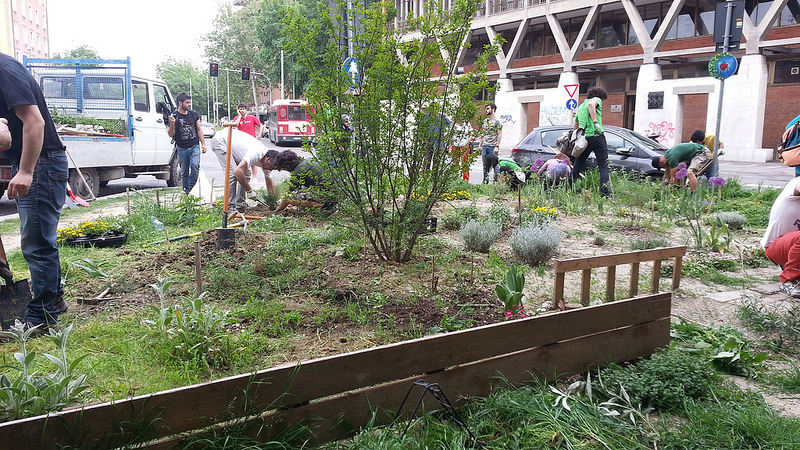Through the Looking Glass: why public engagement in cities should be about (more than) reflexion/reflection
Place-making affects all of us. Yet how many of us, apart from place-making professionals and decision-makers, can really shape the places we live in? This post argues that engaging the public in place-making should at least be about mutual learning, dialogue and collaboration. Reflexivity and dialogue allow us to cast a new look on the world. In-so-doing, public engagement as a collective learning process can also transform us and the places we live in, and enable to work toward creative solutions. But mind the cracks in the mirror!
People, places and placemaking
We inhabit places as much as places inhabit us. The places we live in can largely shape our quality of life. People also contribute to shape places on a daily, often taken-for-granted basis. Yet how much are places are a reflection of who we really aspire to be? People’s ability to effectively shape places in ways that are meaningful to them can face multiple hurdles. Politics and power can enable as much as they can thwart people’s ability to shape the places they live in, and operate at a multiple scales, from the local to the international level. Particularly, the constraining forces of networked globalisation can limit our current and future opportunities for placemaking, which in turn will largely shape our own identities. Even the New Urbanist movement, despite its laudable attempt to make people-friendly places through innovative participatory design charrettes, can also fall prey to the globalisation/internationalisation syndrome. Likewise, smart city strategies, although marketed as aiming to improve the lives of urban residents, are often driven by high-tech innovation and massive international investment, and can thereby exacerbate social inequalities in existing cities. Placemaking remains as contentious as ever, even under veneers of sustainable development.

(re)Making Places: Guerilla gardeners. Community engagement or contestation? Picture by Zeroincondott*, Flickr, Creative Commons attribution.
Successful planning is about both people and places. The pioneering work of leading researcher-practitioners such as William H. Whyte and Jan Gehl is a testimony to this fact (see for example The Social Life of Small Urban Spaces and its related film). To make people-friendly places, at least some form of public engagement is key. In the words of Fred Kent, founder of the non-profit organisation Project for Public Spaces:
“It takes a place to create a community, and a community to create a place” Fred Kent
This view is shared by Joan Clos, Executive Director of UN-Habitat (see here for an extended overview of his career). Joan Clos views that the “art and science of building cities” is about considering relationship between public space and the built environment, and recognising the central role of people in placemaking. Encouragingly, the New Urban Agenda seems set to promote public space as a medium for greater inclusiveness and well-being, and will hopefully foster enabling forms of public participation.

A modern urban version of Lewis Carroll's Through the Looking Glass? Cloud Gate, aka the "Bean", by sculptor Anish Kapoor in Chicago's Millenium Park. Picture by Tom Rolfe, Flickr, Creative Commons attribution.
Mind the cracks
Public engagement brings its own share of difficulties, however. Large-scale online mapping surveys, for example, can reveal how urban residents may have differing views on urban planning strategies, pitting those supporting urban infill against those favouring a status-quo. Likewise, a 2013 report by the UK Royal Town Planning Institute (RTPI) shows that the provision of large scale housing can be hindered by “loud objectors”, even in the face of housing shortage. The RTPI report highlights the need for improved community engagement, particularly to engage local residents more effectively. With all due respect to Habermas, public engagement seldom seems to forge true consensus.
"If you do not know where you are going, any road will get you there" Lewis Carroll
This reminds me of a conversation I had with a planner in a local authority located in the Stockholm region. After having been head of public engagement for the local council for some years, he expressed that he no longer believed in collaborative planning approaches where planners patiently listen to people’s diverse complaints and wishes. He viewed that people often have only the faintest idea of what planning is really about, or what the planning system can realistically deliver. Instead, he expressed a preference for evidence-based planning and decision-making – an approach that seeks to produce and genuinely consider the hard data about what goes right and what goes wrong within a given place. The main issue at stake for the planner was how to retain an attractive mix of residents within the council, and halt the flight of higher educated (and more well-off) households. I think the planner viewed that public engagement can only function properly on the basis of discussing sound evidence among all relevant stakeholders. Collective learning is a key part of the engagement and collaborative planning process. It is about making informed collective choices rather than pursuing self-interested demands. I am sincerely keen to see whether and how the evidence his council will gather will then be fed back onto the public, and how such informed public engagement will inform better decision-making and improve placemaking within the council.
Public engagement as a mutual learning process has long been advocated by key collaborative governance scholars such as John Forester, Patsy Healey, and Innes Booher. More recently, Stéphane Roche has argued that the smart city resides on the digital and spatial literacy of its residents, as a smart city is first and foremost spatially enabled. This view contrasts with public engagement where people simply defend their own interests. This does not necessarily mean that one should oversimplify the claims of individual interest groups: NIMBYism (Not-in-my-backyard) is not necessarily about ignorant or selfish opposition to changes in the built environment or landscape. Rather, public engagement should probably be about informed and enabled decision-making and management. The more urban residents understand how to engage in the technologically-enabled city, the more meaningful their contribution is likely to become. This said, enabling spatial skills need not be high-tech only: a mix of online and offline technologies, as well as hard and soft data, are required to make public engagement inclusive and planning decisions more in tune with both people and places. Spatial skills also need to be enabled, which is a whole field of enquiry in itself, led by such critical geographers as Sarah Elwood and Rina Ghose. The production and meaningful use of geospatial data remains uneven across society, despite great potential for improved democratisation.
The Looking Glass: from reflection to transformation
Public engagement as a reflexive learning process can not only improve people’s understanding and perception of the world and communities around them, it can also transform both individuals and places in collectively meaningful ways. This calls for an almost philosophical, if not spiritual, form of engagement, which invites us to consider collective interests over personal interests. It also calls for a consideration of people’s ability to reflect and learn. Because of time, incentives, commitments, and endowments, we as individuals all have different capacity for learning about and engaging with placemaking. The necessary learning and discussing environments should be enabling as well as enabled so as to be effective. Reflexive public engagement also begs the following question: How far are we, as individuals and communities, willing to look into, or even step into, the Looking Glass?
When you subscribe to the blog, we will send you an e-mail when there are new updates on the site so you wouldn't miss them.


Comments 2
[…] Read the blog post […]
[…] set of posts about public engagement and many buzzwords around it. I appreciated particularly his discussion of how public engagement could (and should) be more than “reflecting” and be oriented to […]